Evaluating Competitive Strategies in the Higher Education Industry
VerifiedAdded on 2023/06/15
|6
|1584
|73
Report
AI Summary
This report provides an overview of competitive strategies, business model innovation, and the CAGE Framework within the higher education industry, referencing TEQSA, MIT, and the Australian government's education department. It discusses the importance of strategic planning, unique selling propositions, and sustainability in maintaining a competitive edge. The report highlights the need for business model innovation to adapt to growing competition and attract students, using the University of Sydney as an example. Furthermore, it explains how the CAGE framework is used by the Australian government to encourage international students by addressing cultural, administrative, geographic, and economic differences. The analysis emphasizes that these strategies and models are crucial for higher education institutions to achieve competence, contribute to economic growth, and effectively utilize their resources to benefit both domestic and international students. Desklib is a platform where you can find similar assignments.
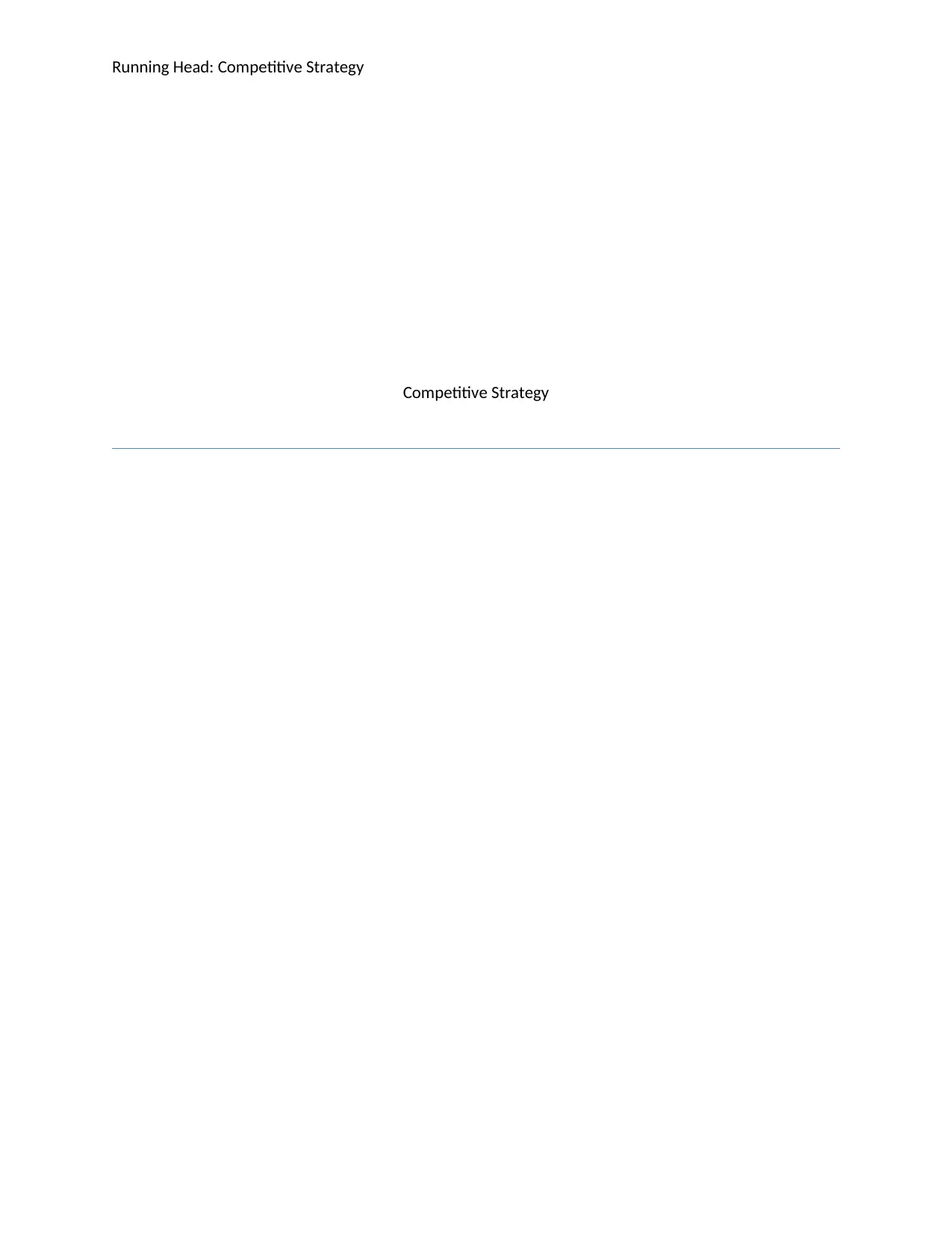
Running Head: Competitive Strategy
Competitive Strategy
Competitive Strategy
Paraphrase This Document
Need a fresh take? Get an instant paraphrase of this document with our AI Paraphraser
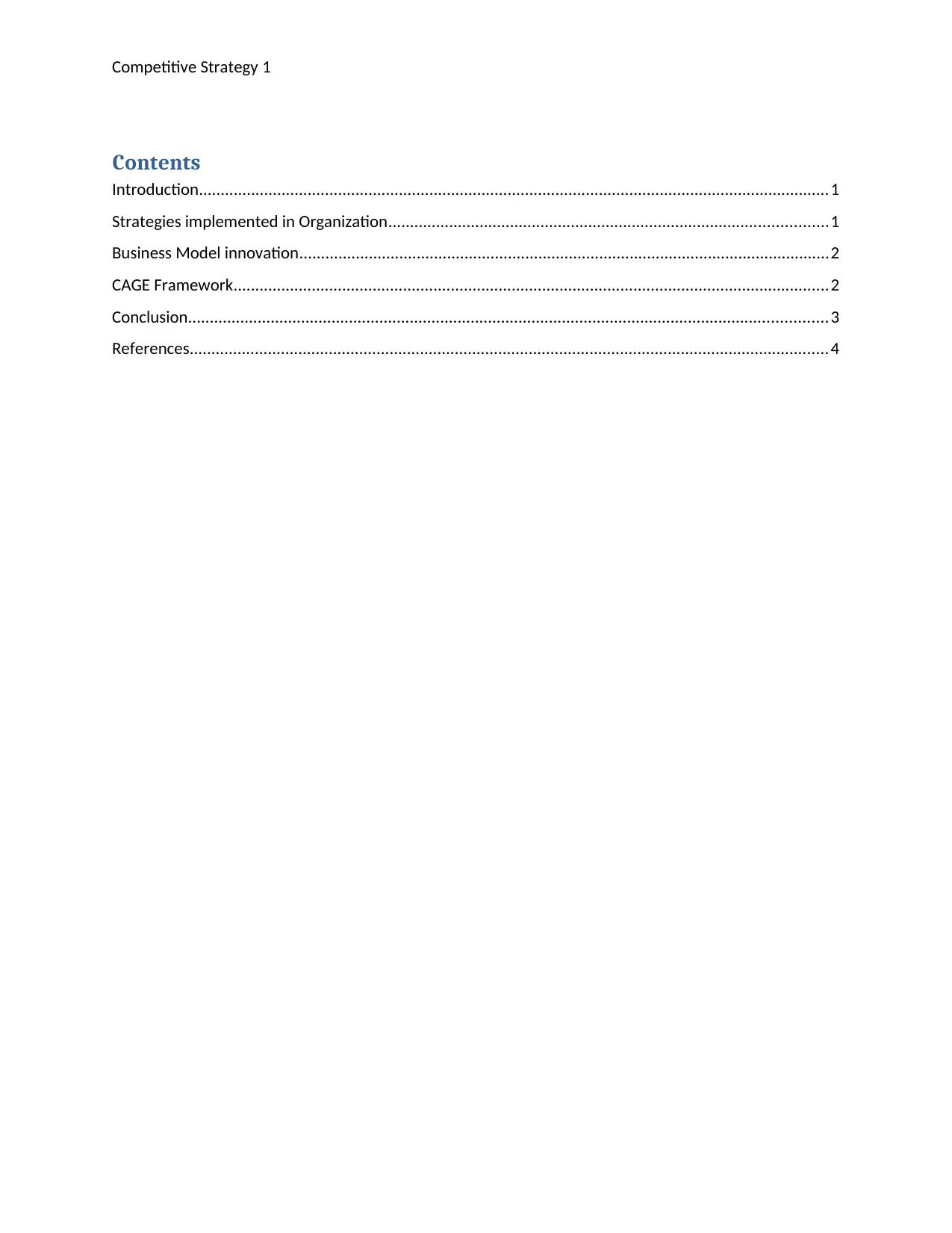
Competitive Strategy 1
Contents
Introduction.................................................................................................................................................1
Strategies implemented in Organization.....................................................................................................1
Business Model innovation..........................................................................................................................2
CAGE Framework.........................................................................................................................................2
Conclusion...................................................................................................................................................3
References...................................................................................................................................................4
Contents
Introduction.................................................................................................................................................1
Strategies implemented in Organization.....................................................................................................1
Business Model innovation..........................................................................................................................2
CAGE Framework.........................................................................................................................................2
Conclusion...................................................................................................................................................3
References...................................................................................................................................................4
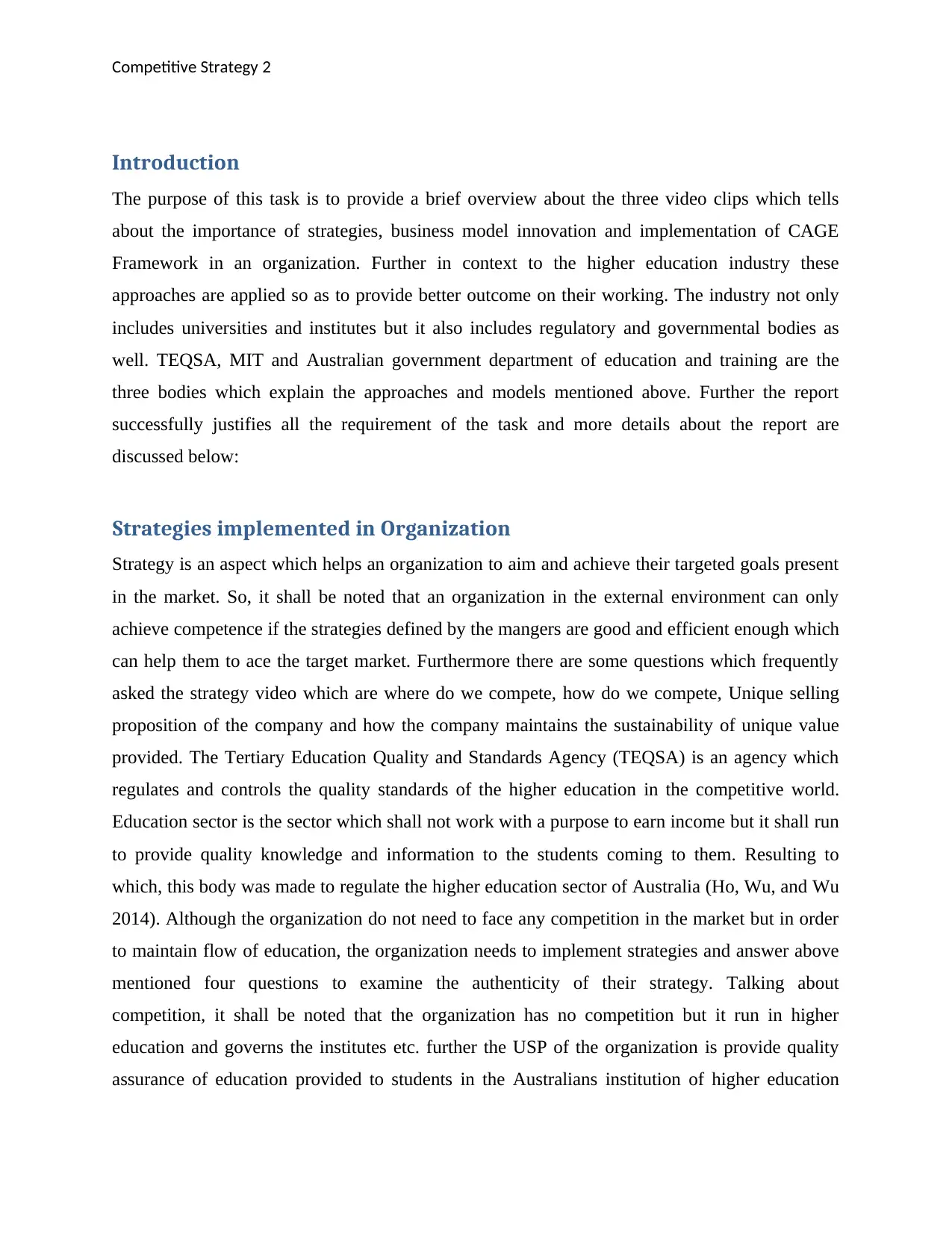
Competitive Strategy 2
Introduction
The purpose of this task is to provide a brief overview about the three video clips which tells
about the importance of strategies, business model innovation and implementation of CAGE
Framework in an organization. Further in context to the higher education industry these
approaches are applied so as to provide better outcome on their working. The industry not only
includes universities and institutes but it also includes regulatory and governmental bodies as
well. TEQSA, MIT and Australian government department of education and training are the
three bodies which explain the approaches and models mentioned above. Further the report
successfully justifies all the requirement of the task and more details about the report are
discussed below:
Strategies implemented in Organization
Strategy is an aspect which helps an organization to aim and achieve their targeted goals present
in the market. So, it shall be noted that an organization in the external environment can only
achieve competence if the strategies defined by the mangers are good and efficient enough which
can help them to ace the target market. Furthermore there are some questions which frequently
asked the strategy video which are where do we compete, how do we compete, Unique selling
proposition of the company and how the company maintains the sustainability of unique value
provided. The Tertiary Education Quality and Standards Agency (TEQSA) is an agency which
regulates and controls the quality standards of the higher education in the competitive world.
Education sector is the sector which shall not work with a purpose to earn income but it shall run
to provide quality knowledge and information to the students coming to them. Resulting to
which, this body was made to regulate the higher education sector of Australia (Ho, Wu, and Wu
2014). Although the organization do not need to face any competition in the market but in order
to maintain flow of education, the organization needs to implement strategies and answer above
mentioned four questions to examine the authenticity of their strategy. Talking about
competition, it shall be noted that the organization has no competition but it run in higher
education and governs the institutes etc. further the USP of the organization is provide quality
assurance of education provided to students in the Australians institution of higher education
Introduction
The purpose of this task is to provide a brief overview about the three video clips which tells
about the importance of strategies, business model innovation and implementation of CAGE
Framework in an organization. Further in context to the higher education industry these
approaches are applied so as to provide better outcome on their working. The industry not only
includes universities and institutes but it also includes regulatory and governmental bodies as
well. TEQSA, MIT and Australian government department of education and training are the
three bodies which explain the approaches and models mentioned above. Further the report
successfully justifies all the requirement of the task and more details about the report are
discussed below:
Strategies implemented in Organization
Strategy is an aspect which helps an organization to aim and achieve their targeted goals present
in the market. So, it shall be noted that an organization in the external environment can only
achieve competence if the strategies defined by the mangers are good and efficient enough which
can help them to ace the target market. Furthermore there are some questions which frequently
asked the strategy video which are where do we compete, how do we compete, Unique selling
proposition of the company and how the company maintains the sustainability of unique value
provided. The Tertiary Education Quality and Standards Agency (TEQSA) is an agency which
regulates and controls the quality standards of the higher education in the competitive world.
Education sector is the sector which shall not work with a purpose to earn income but it shall run
to provide quality knowledge and information to the students coming to them. Resulting to
which, this body was made to regulate the higher education sector of Australia (Ho, Wu, and Wu
2014). Although the organization do not need to face any competition in the market but in order
to maintain flow of education, the organization needs to implement strategies and answer above
mentioned four questions to examine the authenticity of their strategy. Talking about
competition, it shall be noted that the organization has no competition but it run in higher
education and governs the institutes etc. further the USP of the organization is provide quality
assurance of education provided to students in the Australians institution of higher education
⊘ This is a preview!⊘
Do you want full access?
Subscribe today to unlock all pages.

Trusted by 1+ million students worldwide
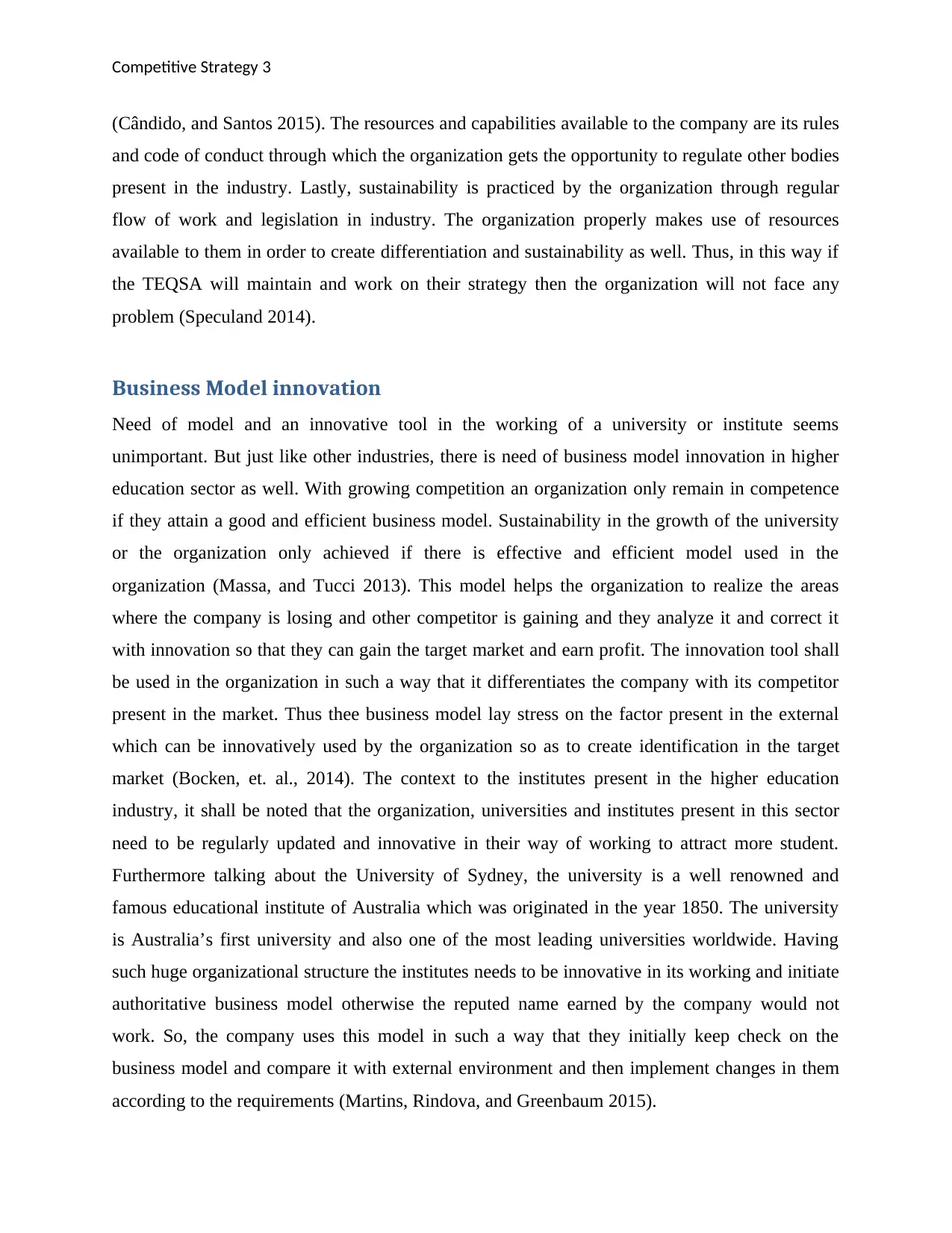
Competitive Strategy 3
(Cândido, and Santos 2015). The resources and capabilities available to the company are its rules
and code of conduct through which the organization gets the opportunity to regulate other bodies
present in the industry. Lastly, sustainability is practiced by the organization through regular
flow of work and legislation in industry. The organization properly makes use of resources
available to them in order to create differentiation and sustainability as well. Thus, in this way if
the TEQSA will maintain and work on their strategy then the organization will not face any
problem (Speculand 2014).
Business Model innovation
Need of model and an innovative tool in the working of a university or institute seems
unimportant. But just like other industries, there is need of business model innovation in higher
education sector as well. With growing competition an organization only remain in competence
if they attain a good and efficient business model. Sustainability in the growth of the university
or the organization only achieved if there is effective and efficient model used in the
organization (Massa, and Tucci 2013). This model helps the organization to realize the areas
where the company is losing and other competitor is gaining and they analyze it and correct it
with innovation so that they can gain the target market and earn profit. The innovation tool shall
be used in the organization in such a way that it differentiates the company with its competitor
present in the market. Thus thee business model lay stress on the factor present in the external
which can be innovatively used by the organization so as to create identification in the target
market (Bocken, et. al., 2014). The context to the institutes present in the higher education
industry, it shall be noted that the organization, universities and institutes present in this sector
need to be regularly updated and innovative in their way of working to attract more student.
Furthermore talking about the University of Sydney, the university is a well renowned and
famous educational institute of Australia which was originated in the year 1850. The university
is Australia’s first university and also one of the most leading universities worldwide. Having
such huge organizational structure the institutes needs to be innovative in its working and initiate
authoritative business model otherwise the reputed name earned by the company would not
work. So, the company uses this model in such a way that they initially keep check on the
business model and compare it with external environment and then implement changes in them
according to the requirements (Martins, Rindova, and Greenbaum 2015).
(Cândido, and Santos 2015). The resources and capabilities available to the company are its rules
and code of conduct through which the organization gets the opportunity to regulate other bodies
present in the industry. Lastly, sustainability is practiced by the organization through regular
flow of work and legislation in industry. The organization properly makes use of resources
available to them in order to create differentiation and sustainability as well. Thus, in this way if
the TEQSA will maintain and work on their strategy then the organization will not face any
problem (Speculand 2014).
Business Model innovation
Need of model and an innovative tool in the working of a university or institute seems
unimportant. But just like other industries, there is need of business model innovation in higher
education sector as well. With growing competition an organization only remain in competence
if they attain a good and efficient business model. Sustainability in the growth of the university
or the organization only achieved if there is effective and efficient model used in the
organization (Massa, and Tucci 2013). This model helps the organization to realize the areas
where the company is losing and other competitor is gaining and they analyze it and correct it
with innovation so that they can gain the target market and earn profit. The innovation tool shall
be used in the organization in such a way that it differentiates the company with its competitor
present in the market. Thus thee business model lay stress on the factor present in the external
which can be innovatively used by the organization so as to create identification in the target
market (Bocken, et. al., 2014). The context to the institutes present in the higher education
industry, it shall be noted that the organization, universities and institutes present in this sector
need to be regularly updated and innovative in their way of working to attract more student.
Furthermore talking about the University of Sydney, the university is a well renowned and
famous educational institute of Australia which was originated in the year 1850. The university
is Australia’s first university and also one of the most leading universities worldwide. Having
such huge organizational structure the institutes needs to be innovative in its working and initiate
authoritative business model otherwise the reputed name earned by the company would not
work. So, the company uses this model in such a way that they initially keep check on the
business model and compare it with external environment and then implement changes in them
according to the requirements (Martins, Rindova, and Greenbaum 2015).
Paraphrase This Document
Need a fresh take? Get an instant paraphrase of this document with our AI Paraphraser
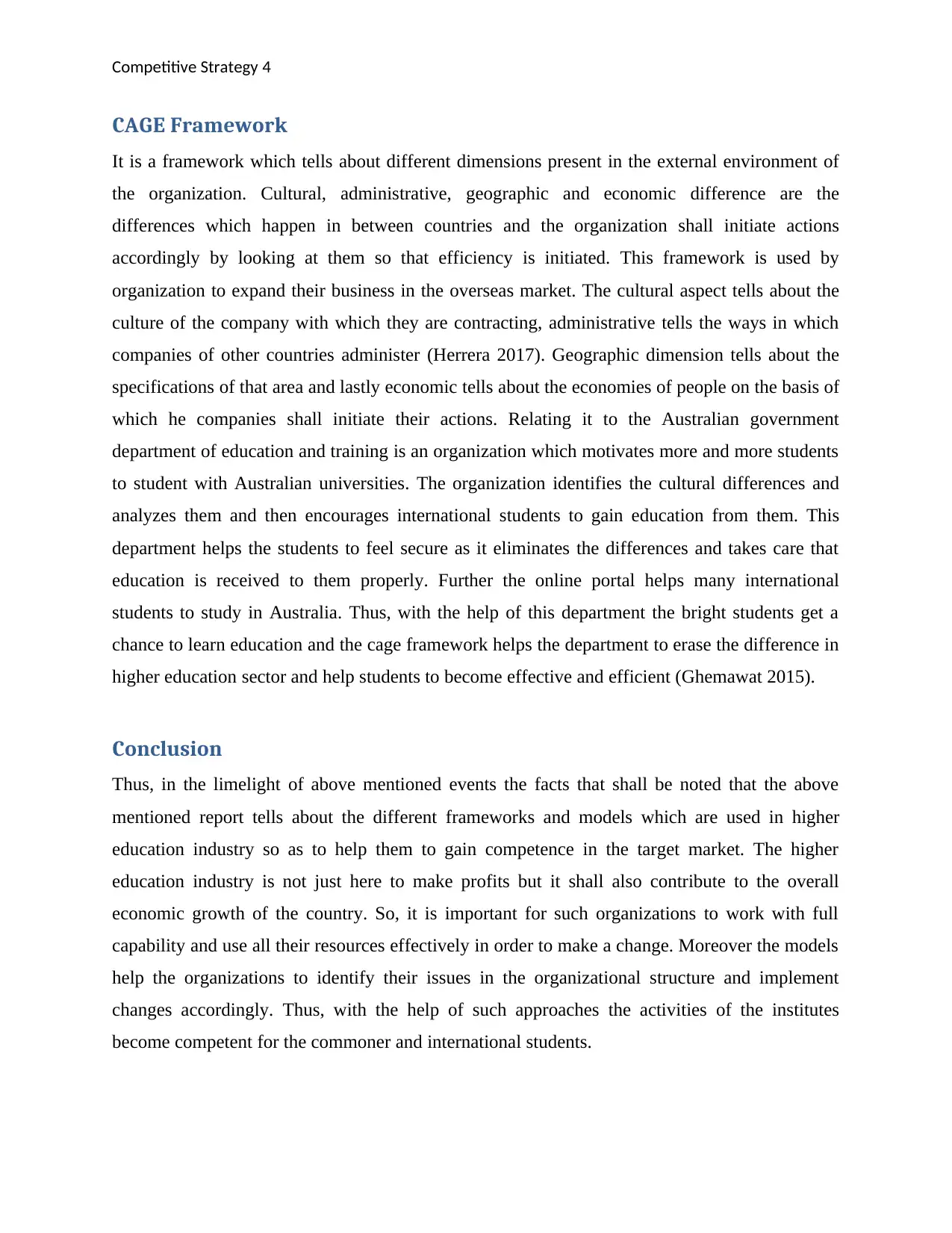
Competitive Strategy 4
CAGE Framework
It is a framework which tells about different dimensions present in the external environment of
the organization. Cultural, administrative, geographic and economic difference are the
differences which happen in between countries and the organization shall initiate actions
accordingly by looking at them so that efficiency is initiated. This framework is used by
organization to expand their business in the overseas market. The cultural aspect tells about the
culture of the company with which they are contracting, administrative tells the ways in which
companies of other countries administer (Herrera 2017). Geographic dimension tells about the
specifications of that area and lastly economic tells about the economies of people on the basis of
which he companies shall initiate their actions. Relating it to the Australian government
department of education and training is an organization which motivates more and more students
to student with Australian universities. The organization identifies the cultural differences and
analyzes them and then encourages international students to gain education from them. This
department helps the students to feel secure as it eliminates the differences and takes care that
education is received to them properly. Further the online portal helps many international
students to study in Australia. Thus, with the help of this department the bright students get a
chance to learn education and the cage framework helps the department to erase the difference in
higher education sector and help students to become effective and efficient (Ghemawat 2015).
Conclusion
Thus, in the limelight of above mentioned events the facts that shall be noted that the above
mentioned report tells about the different frameworks and models which are used in higher
education industry so as to help them to gain competence in the target market. The higher
education industry is not just here to make profits but it shall also contribute to the overall
economic growth of the country. So, it is important for such organizations to work with full
capability and use all their resources effectively in order to make a change. Moreover the models
help the organizations to identify their issues in the organizational structure and implement
changes accordingly. Thus, with the help of such approaches the activities of the institutes
become competent for the commoner and international students.
CAGE Framework
It is a framework which tells about different dimensions present in the external environment of
the organization. Cultural, administrative, geographic and economic difference are the
differences which happen in between countries and the organization shall initiate actions
accordingly by looking at them so that efficiency is initiated. This framework is used by
organization to expand their business in the overseas market. The cultural aspect tells about the
culture of the company with which they are contracting, administrative tells the ways in which
companies of other countries administer (Herrera 2017). Geographic dimension tells about the
specifications of that area and lastly economic tells about the economies of people on the basis of
which he companies shall initiate their actions. Relating it to the Australian government
department of education and training is an organization which motivates more and more students
to student with Australian universities. The organization identifies the cultural differences and
analyzes them and then encourages international students to gain education from them. This
department helps the students to feel secure as it eliminates the differences and takes care that
education is received to them properly. Further the online portal helps many international
students to study in Australia. Thus, with the help of this department the bright students get a
chance to learn education and the cage framework helps the department to erase the difference in
higher education sector and help students to become effective and efficient (Ghemawat 2015).
Conclusion
Thus, in the limelight of above mentioned events the facts that shall be noted that the above
mentioned report tells about the different frameworks and models which are used in higher
education industry so as to help them to gain competence in the target market. The higher
education industry is not just here to make profits but it shall also contribute to the overall
economic growth of the country. So, it is important for such organizations to work with full
capability and use all their resources effectively in order to make a change. Moreover the models
help the organizations to identify their issues in the organizational structure and implement
changes accordingly. Thus, with the help of such approaches the activities of the institutes
become competent for the commoner and international students.
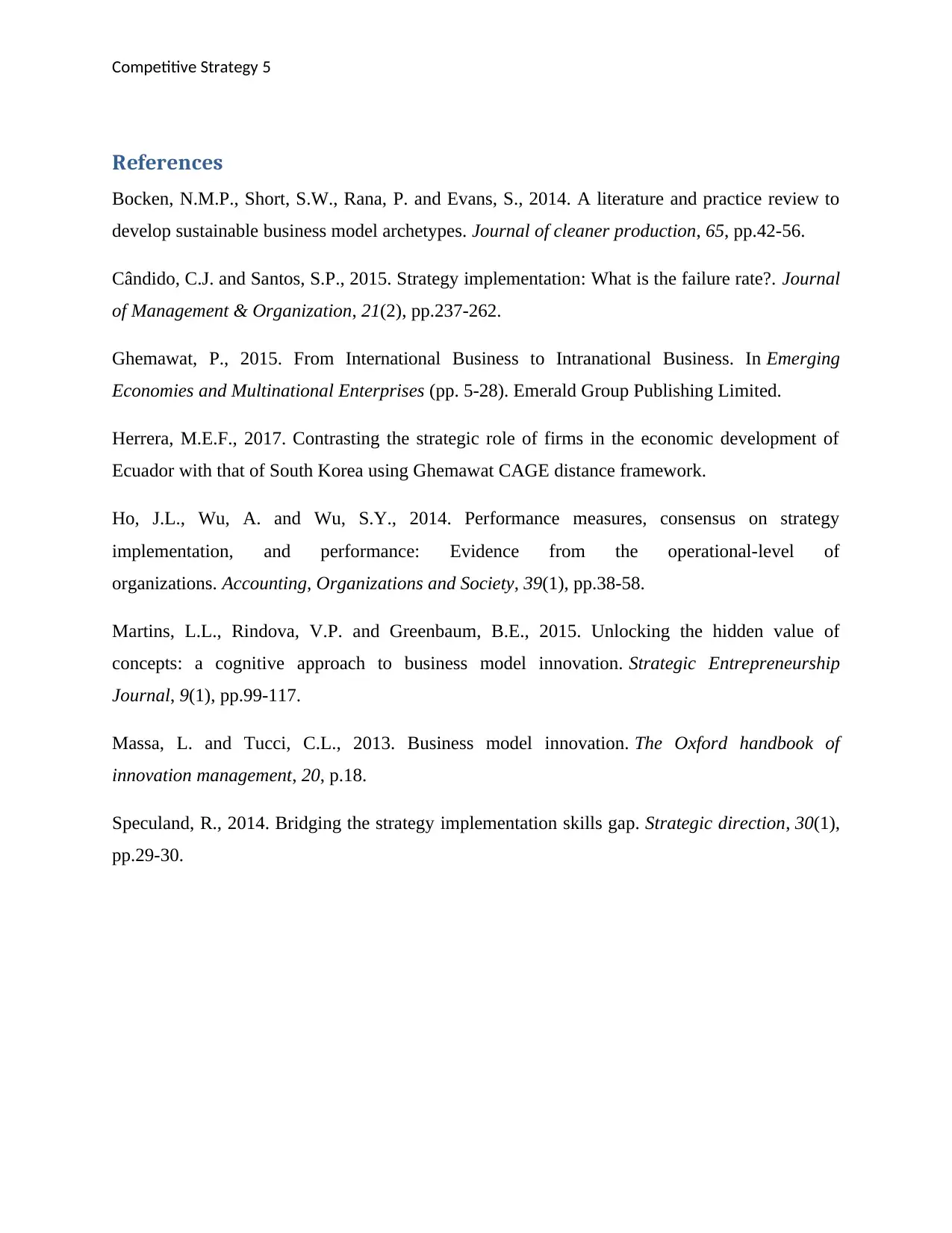
Competitive Strategy 5
References
Bocken, N.M.P., Short, S.W., Rana, P. and Evans, S., 2014. A literature and practice review to
develop sustainable business model archetypes. Journal of cleaner production, 65, pp.42-56.
Cândido, C.J. and Santos, S.P., 2015. Strategy implementation: What is the failure rate?. Journal
of Management & Organization, 21(2), pp.237-262.
Ghemawat, P., 2015. From International Business to Intranational Business. In Emerging
Economies and Multinational Enterprises (pp. 5-28). Emerald Group Publishing Limited.
Herrera, M.E.F., 2017. Contrasting the strategic role of firms in the economic development of
Ecuador with that of South Korea using Ghemawat CAGE distance framework.
Ho, J.L., Wu, A. and Wu, S.Y., 2014. Performance measures, consensus on strategy
implementation, and performance: Evidence from the operational-level of
organizations. Accounting, Organizations and Society, 39(1), pp.38-58.
Martins, L.L., Rindova, V.P. and Greenbaum, B.E., 2015. Unlocking the hidden value of
concepts: a cognitive approach to business model innovation. Strategic Entrepreneurship
Journal, 9(1), pp.99-117.
Massa, L. and Tucci, C.L., 2013. Business model innovation. The Oxford handbook of
innovation management, 20, p.18.
Speculand, R., 2014. Bridging the strategy implementation skills gap. Strategic direction, 30(1),
pp.29-30.
References
Bocken, N.M.P., Short, S.W., Rana, P. and Evans, S., 2014. A literature and practice review to
develop sustainable business model archetypes. Journal of cleaner production, 65, pp.42-56.
Cândido, C.J. and Santos, S.P., 2015. Strategy implementation: What is the failure rate?. Journal
of Management & Organization, 21(2), pp.237-262.
Ghemawat, P., 2015. From International Business to Intranational Business. In Emerging
Economies and Multinational Enterprises (pp. 5-28). Emerald Group Publishing Limited.
Herrera, M.E.F., 2017. Contrasting the strategic role of firms in the economic development of
Ecuador with that of South Korea using Ghemawat CAGE distance framework.
Ho, J.L., Wu, A. and Wu, S.Y., 2014. Performance measures, consensus on strategy
implementation, and performance: Evidence from the operational-level of
organizations. Accounting, Organizations and Society, 39(1), pp.38-58.
Martins, L.L., Rindova, V.P. and Greenbaum, B.E., 2015. Unlocking the hidden value of
concepts: a cognitive approach to business model innovation. Strategic Entrepreneurship
Journal, 9(1), pp.99-117.
Massa, L. and Tucci, C.L., 2013. Business model innovation. The Oxford handbook of
innovation management, 20, p.18.
Speculand, R., 2014. Bridging the strategy implementation skills gap. Strategic direction, 30(1),
pp.29-30.
⊘ This is a preview!⊘
Do you want full access?
Subscribe today to unlock all pages.

Trusted by 1+ million students worldwide
1 out of 6
Related Documents
Your All-in-One AI-Powered Toolkit for Academic Success.
+13062052269
info@desklib.com
Available 24*7 on WhatsApp / Email
![[object Object]](/_next/static/media/star-bottom.7253800d.svg)
Unlock your academic potential
Copyright © 2020–2025 A2Z Services. All Rights Reserved. Developed and managed by ZUCOL.




